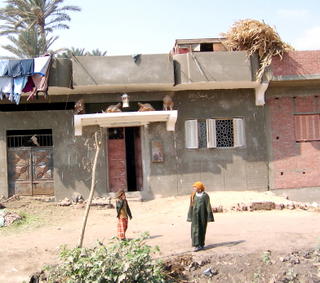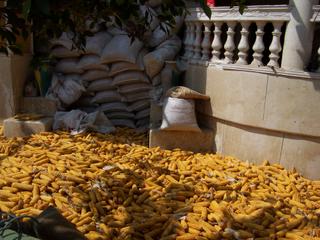 They say that summer colds are the worst and I'm inclined to believe them. A nasty virus hit Cairo mid-September that really laid a lot of people low, myself included. Not being able to breathe really cuts down on one's riding enjoyment, not to mention the fact that every time I did something over that month, the bug's hammerlock on my chest got tighter. So the horses got a bit of a holiday. But holidays are over, we are all breathing again and it's back to work.
They say that summer colds are the worst and I'm inclined to believe them. A nasty virus hit Cairo mid-September that really laid a lot of people low, myself included. Not being able to breathe really cuts down on one's riding enjoyment, not to mention the fact that every time I did something over that month, the bug's hammerlock on my chest got tighter. So the horses got a bit of a holiday. But holidays are over, we are all breathing again and it's back to work.A couple of weeks ago, I set out with some friends to investigate the route from the paddocks to a tapestry weaving centre, the Wissa Wassef Centre near the Moneeb expressway and the Maryouteya Road. The centre was established many years ago by a talented Egyptian architect who felt that the local children needed an artistic outlet, so he took the children on outings, taught them how to dye yarn and how to weave kilims, and turned them loose artistically. The results were astonishing. Wissa Wassef then built a home and a museum to house the weavings in the traditional style of architecture of domes and courtyards. The Centre itself won an Aga Khan award for design. I've taken many friends there over the years to see the tapestries, the pottery, the batiks, and the lovely garden, but this was the first time to try it on horseback.
We set out along the trails with a pretty good idea of where we were going, thanks to Google Earth. The route took us through a couple of small villages at the outskirts of Shubramant, one of which had the house in the photo, sporting a group of enormous plaster roast chickens. The logic of placing a grouping of roast chickens over one's front door still escapes me, but the image was delightful, so we stopped to get a few shots of them, to the amusement of the girls sitting by the front door. They very graciously offered us a chicken if we liked them so much, but we pointed out that they were hardly easily carried on horseback. Oh well.

After about an hour of meandering along canals, we entered the village of Harania, where the Wissa Wassef museum is located. As we were riding along the main street, a front garden full of brilliant yellow ears of corn caught our eyes. Apparently someone had decided that this would be a great place to store his corn crop, to our delight. People walking by asked why we were taking photos of some corn and most of them nodded in agreement when we mentioned the rich yellow colour. Shortly thereafter the village houses thinned out and we arrived at the shady dirt road where the museum is set. The gates were open for a busload of tourists, but the doorman was rather taken aback when three women on horseback entered. Fortunately, I have a good friend who rents a house in the back of the compound, so I just told him that we were visiting Pat. We did, in fact, ride back to say hello.

On the way out we stopped to take a look at the museum where we found workmen hanging new tapestries to take the temporary places of those that have traveled to London for an exhibition there. One of my favourites, one depicting the wheat harvest, was still hanging in its place, but a famous battle scene was gone. Still, it was marvelous to once again see the world through the eyes of the villagers who had woven the tapestries.
As we were leaving, I had to stop to take a photo of a bronze donkey that has stood in the garden of the centre for many years. Every time I've come to the centre, I've stopped to pet it and admire this simple sculpture that so beautifully captures the essence of the animal that is the mainstay of Egypt.
 My companion mentioned that the sculptor had his studio not far from the tapestry centre so we went to find it just down the road a short distance.
My companion mentioned that the sculptor had his studio not far from the tapestry centre so we went to find it just down the road a short distance.There we found a garden of delight. Adam Henein, the sculptor of the Wissa Wassef donkey and a set of others, among many other pieces, is in his seventies now but still active and working in his countryside studio. He was intrigued that three women would drop by on horseback and invited us in. We wandered around his garden admiring his work for some time, chatting with him about this and that. He was delighted at having visitors on horseback. We were delighted to meet such a charming man. One of the outstanding aspects of his little garden is a granite ship upon which are placed various pieces of sculpture. Dreams of owning a piece will likely remain as dreams, however, since he is a very well-known sculptor having shown in many major museums and galleries in Europe and North America over the years.

Eventually we had to make our farewells and head back to the paddocks. It isn't every day that you go to a museum and a sculptor's atelier on horseback. Only in Egypt.
copyright 2005 Maryanne Stroud Gabbani





